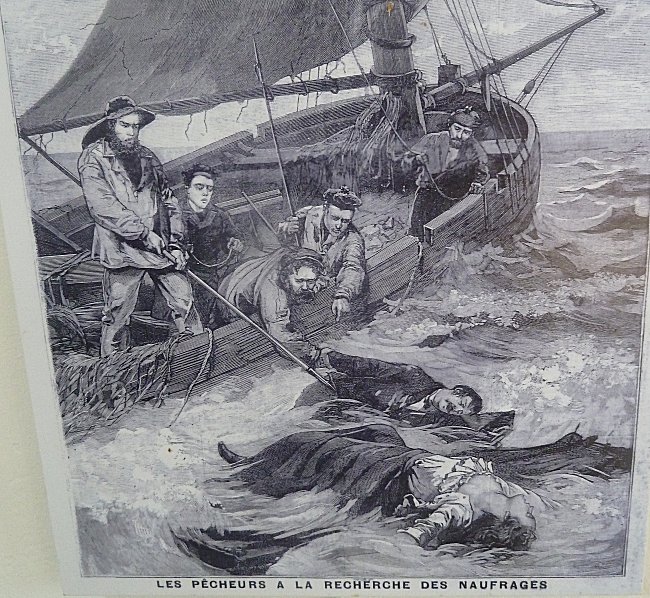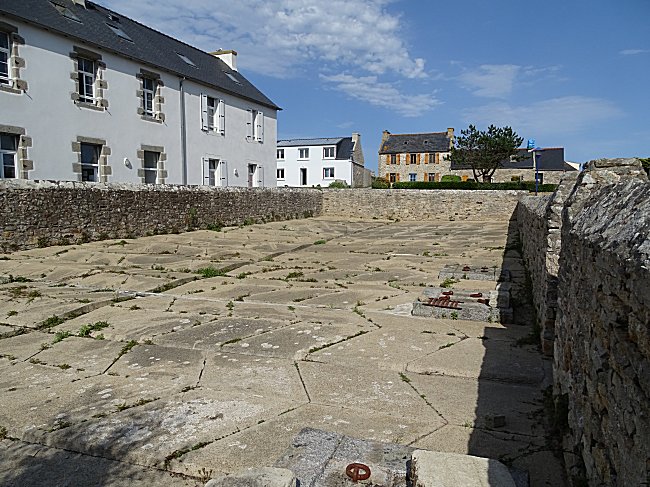This is a small museum entirely dedicated to the memory of a shipwreck that profoundly marked the minds of people at the end of the 19th century throughout the Iroise Country. One cannot visit Molène and ignore it because the inhabitants have been and are still by this tragedy.
Access:
From the pier, head towards the village and follow the first street on the left. Pass in front of the old restaurant Kastell an Daol. The museum is located a little further on the left side of the street.
A major shipwreck

Scale model 1/50 of "The Drummond Castle",
An english steamer 110 m long and 13 m wide.
The British flag was offered by Queen Elizabeth II.
Directed by Gérard Caraven 1999.

For more details, see the bottom of this page "Read more".
There have been many questions about the reasons for such a disaster when the sea was so calm. Apparently, this was a fairly frequent navigational error at the time : the captain thought he had past Ushant when it was Molène. There was talk of a lack visibility : falling night and thick fog. However, another English ship further offshore saw The Drummond Castle moving between the two islands into the Fromveur instead of entering the English Channel. In 1896, there was obviously no radar or GPS. The lighthouse of the Jument, between Molène and Ushant, had not yet been built. The vessel was of single construction. The metal hull was ripped open at the front below the waterline when it hit the submerged rocks known by Breton fishermen as "Baz ar Melle Bihan"1 , and the water soon engulfed the ship and it floundered.
The dedication of an entire population
It was only when dawn broke that the islanders were aware of the shipwreck. The museum retells event by event the rescue of the first few survivors, the discovery lifeless bodies, and many floating objects. Despite the ancestral rivalry between France and England, two major maritime powers engaged in competing colonial expansionism at the time, the inhabitants of Molène showed enormous dedication and compassion. The same was true in Ushant and in the other municipalities of the Iroise Country where floating bodies were found. Disregarding the subtleties that separated Protestant and Catholic customs, all the bodies found were carefully identified and respectfully buried. In Molène, 29 bodies in all were solemnly buried in the English cemetery.


The total number of victims of the shipwreck is not well known mainly because the press articles of the time contradict each other. Some take into account the total number of passengers the ship could carry : 380 passengers and 103 crew. However, the ship was not full. Others only report the number of passengers departing from Cape Town, at least 137, plus 7 people taken on board at the Las Palmas stopover. We cannot rely on the number of bodies cast up by the sea, because some of them were still being washed at shore after the press release. It is simpler to say that there were about 250 victims. What is certain is that only 3 survivors were rescued : one passenger and two crew members.

The English cemetery
Relics...

It took many years to find the wreckage, which is still lying at the entrance to the Fromveur in 66 m of water. First, it was Italian scrap metal workers who, with the help of explosives, brought up fragments of the hull. Then, in 1979, a Breton diver to whom we owe the elements exhibited in the windows of the museum and the semaphore. To these relics must be added debris of all kinds found at sea or washed up on the coast shortly after the shipwreck. They are carefully preserved by the families of Molène, Ushant and the coastal communes.
England grateful
The shipwreck obviously was headline news in Great Britain, where the press quickly covered the event, stressing in particular the heroic rescues, the intense searches and, above all, the dedication of an entire population to give the bodies of the drowned ceremonially burials. The Archbishop of Canterbury offered the church a superb gilt chalice and a gold paten. Queen Victoria awarded medals to the rescuers and searchers. The Maritime Prefect of Brest was knighted by the Quenn.
But the recognition of the English was not limited to individual decorations. To collectively thank the Inhabitants, the British built a rainwater collecting cistern system and installed it on the island. This was a godsend, as they were, in desperate need of a more efficient supply of fresh water. Fishermen always moaned that they never knew the best time of day when to head back to port to take advantage of the rising tide, so the English had a special three-dial clock made by London's finest craftsman which was placed on the bell tower. In Ushant, the church gained a new spi.

The chalice and paten offered by the Archbishop of Canterbury
visible in St. Ronan's Church

The English cistern located near the church

The three-dial clock mechanism
All these gestures of gratitude and generosity touched the inhabitants who thought they had only done their duty, as they would have done to their kind.
It is therefore a huge chunk of Molene's memory that the visitor discovers in this museum. Take the time to dwell on it, read the documents provided and why not acquire the works below for further reading that will prolong a memorable visit.
-1-
Journalists and investigators at the time and investigators talked about "Les Pierres vertes" rocks as the possible point of impact. This seems unlikely as the wreck sank quickly and lies too far from these rocks. The local fishermen favour a site closer to the coast on rocks in shallow water that, although below the surface, can be clearly seen at low tide. This dangerous rock that does not appear on the charts is known locally as Baz ar Melle Bihan ( Little joint).
Thanks to Jean Maout, historian of Molène, for this clarification and his collaboration.
Thanks too to Glyn Orpwood who reread this text and modified the English version.
***
READ MORE
We advise you to read the page on the island's website dedicated to the shipwreck of The Drummond Castle. Drummond-Castle
Written by Jean MAOUT after painstaking archival research, this extremely detailed page describes the disaster, the rescue of survivors, the burial of the bodies and the search for the wreck.
The following books also retell the story :

Ed. Bartillat 1999

Ed. Le Télégramme 2004

Ed. Nabu Press 2010







